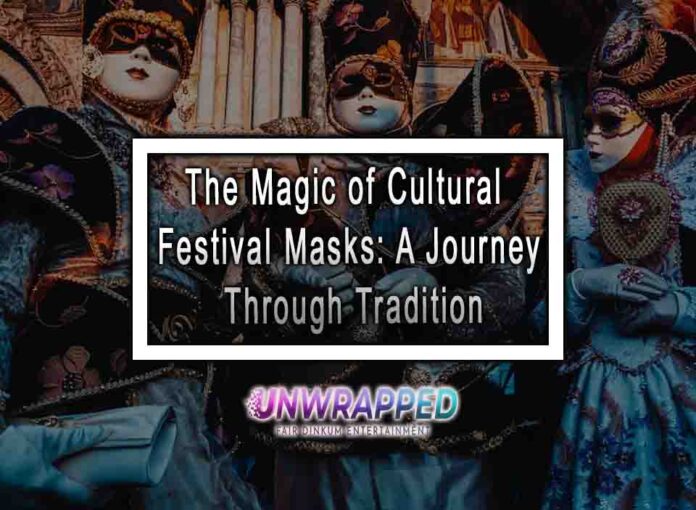The Significance of Masks in Cultural Festivals: Unmasking the Magic!
Step into a world where tradition, art, and mystique intertwine, creating a kaleidoscope of cultural celebrations that leave us spellbound. From the vibrant parades of Carnival to the ancient rituals of indigenous tribes, masks take center stage, adding an enchanting layer to the festivities. In this captivating journey, we will delve into the mesmerizing realm of masks and discover the profound significance they hold in various cultural festivals around the globe.
1. Carnival of Venice: Where Elegance Meets Extravagance
The iconic Carnival of Venice, Italy, is more than just a festival; it’s a symphony of opulence and allure that enchants spectators and participants alike. The masks, adorned with intricate designs, delicate lace, and a dazzling array of feathers, gems, and glistening paint, transport revelers to a bygone era of grandeur and sophistication. These masks, dating back to the 13th century, served a revolutionary purpose – they allowed people from different social classes to intermingle freely, transcending barriers and creating an atmosphere of equality and unity that continues to be celebrated today.
2. Dia de los Muertos: Honoring Ancestral Spirits
Mexico’s Dia de los Muertos, or the Day of the Dead, is a vibrant and deeply spiritual commemoration that radiates a sense of life, rather than mourning. Elaborate masks painted as intricate sugar skulls are not mere decorations; they symbolize the profound cycle of life and death that is at the heart of this festival. As celebrants don these masks, they establish a profound connection between the living and the deceased, creating a bridge of memories, love, and reverence for ancestors that stretches across generations.
3. Bhutan’s Paro Tsechu: Channeling Ancient Deities
In the mystical lands of Bhutan, the Paro Tsechu unfolds as a captivating dance festival that reverberates with spiritual significance. The elaborate masks, painstakingly crafted to represent deities, historical figures, and celestial beings, take on a life of their own as performers wear them with reverence. Beyond their ornate appearance, these masks serve a deeper purpose – they channel the spirits they portray, acting as conduits between the earthly realm and the divine. This profound connection safeguards against malevolent forces and ensures blessings for the entire community.
4. Native American Potlatch Celebrations: Expressing Tribal Identity
For many indigenous tribes in North America, potlatch ceremonies are more than just gatherings; they are powerful expressions of cultural identity and heritage. Intricately carved wooden masks, each telling a unique story through their detailed features, are not just artistic creations; they serve as vessels of tradition and knowledge. These masks, representing spirits, animals, and revered ancestors, play a vital role in storytelling, connecting generations and preserving the collective wisdom of the tribe. With every dance and gesture, these masks breathe life into ancient narratives and keep the flame of tradition alive.
5. Chinese New Year: Warding Off Malevolent Forces
Step into the jubilant world of Chinese New Year, where masks become vibrant symbols of protection and prosperity. Rooted in centuries-old customs, these masks, often adorned in vibrant red and embellished with golden accents, hold a dual significance. Beyond their aesthetic appeal, they serve a crucial role in warding off malevolent spirits and ushering in good fortune for the coming year. As families gather to celebrate, the masks symbolize unity and joy, creating a harmonious atmosphere that resonates with the festive spirit.
6. African Mask Festivals: Celebrating Ancestral Spirits
Across the diverse landscapes of Africa, mask festivals form a tapestry of cultural celebrations that celebrate ancestral spirits, mark rites of passage, and honor bountiful harvests. From the striking wooden masks of the Dan tribe in Ivory Coast to the intricate, beaded masks of the Zulu people, each mask encapsulates the essence of a community’s beliefs and traditions. These masks are not mere adornments; they embody the spirit of a people, serving as channels through which ancestral wisdom flows into the present. With every dance, these masks bridge the gap between generations and pay homage to the intricate web of heritage that binds them.
Embracing the Enchantment: Masks as Cultural Treasures
As we conclude our journey through the captivating realm of masks in cultural festivals, one thing becomes strikingly clear: masks are not just accessories, but intricate gateways to the past, bridges to the spiritual, and symbols of unity. These remarkable creations transcend their physical form, breathing life into age-old traditions and infusing modern celebrations with the wisdom and legacy of generations. So, the next time you find yourself entranced by a masked dancer’s graceful movements or immersed in the mystique of a masked procession, remember that you are partaking in a timeless tapestry woven with threads of culture, identity, and the boundless human spirit.
(Note: The above listicle has been expanded to provide more detailed descriptions and insights into the significance of masks in cultural festivals. It maintains the requested format and focuses on the enchanting aspects of these traditions.)
Discover more: 10 Green Art Festivals Balancing Creativity and Sustainability










